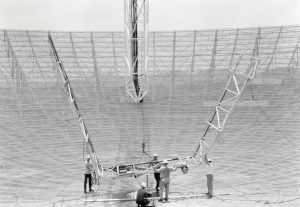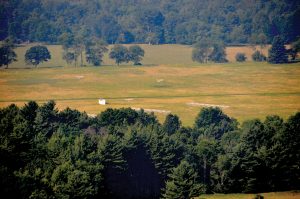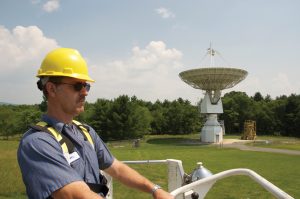The 300-foot telescope in Green Bank, West Virginia after its completion in September 1962.


Early Aerial Over Green Bank
This aerial photograph was taken three years after the 300-foot telescope was completed in Green Bank, West Virginia. The trackway for the Green Bank Interferometer (GBI) can be seen, and off to the left would have been the second 85-foot Blaw Knox telescope, the 85-2, that formed our first interferometer.

Paving the Way for Serious Research
When the 300-foot Telescope was completed in 1962, it quickly became a busy instrument used by astronomers from around the world. It was the world’s largest single-dish telescope, and certainly an impressive view for staff and residents of Green Bank, West Virginia.

Traveling Feed
The 300-foot telescope in Green Bank, West Virginia observed cosmic radio sources by riding the Earth turning underneath them, bringing them into its field of view for about 40 seconds. The receiver feeds of the 300-foot were on a small mount that drove against the Earth’s direction of spin, letting them track cosmic radio sources for a few extra minutes of observing time before the spinning Earth dragged the telescope too far out from underneath the source. In this photo, workers are readying that traveling feed for installation.

Aerial View of a Field of Aerials
In Green Bank, West Virginia sits a field of 64 antennas made by our machinists. These antennas are searching the distant Universe for the first starlight the Cosmos ever produced, billions of years ago. The project is called PAPER, the Precision Array for Probing the Epoch of Reionization. It is a partnership between NRAO staff scientists and scientists at UC-Berkeley, the University of Virginia, the University of Pennsylvania, and the Square Kilometer Array of South Africa.

View from the Cherry Picker
Daryl Shinaberry rides the cherry picker in Green Bank, West Virginia as part of routine inspection and maintenance of the antennas. In the background is the 20-meter robotic telescope used for student research projects.





